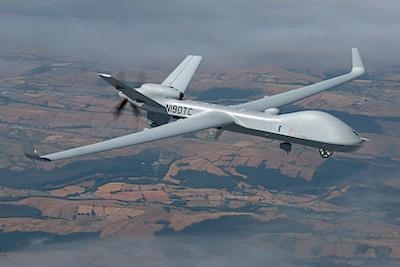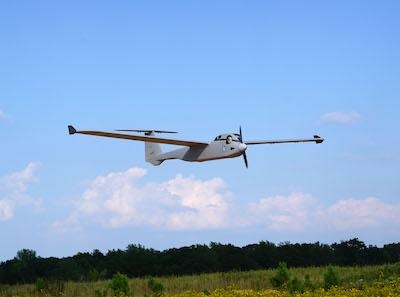Information Presented During Panel Discussion At AUVSI Conference In Chicago
NASA began outreach efforts for the upcoming Systems Integration and Operationalization (SIO) demonstration in 2020 at a panel discussion at the Association for Unmanned Vehicle Systems International (AUVSI) Xponential, All Things Unmanned conference in Chicago from April 30 through May 2.

SIO is a partnership between NASA and industry partners with the goal of accelerating routine Unmanned Aircraft System (UAS) operations into the National Airspace System (NAS). The three partners, Bell, General Atomics-Aeronautical Systems, Inc., and PAE ISR will perform flight demonstrations at altitudes above 500 feet during the summer of 2020.
Jonathan Neptune, General Atomics-ASI project engineer, Richard Brasel, PAE ISR business development executive, and Jennifer Andrews, Bell project engineer comprised the panel. Kurt Swieringa, the SIO technical manager from NASA Langley Research Center in Virginia, served as the panel moderator.
Panelists discussed their visions for future commercial UAS operations and plans for flight demonstrations in the NAS, which will highlight commercial UAS missions that have the potential to provide economic and public benefit.

The flight demonstrations are expected to include UAS with integrated Detect and Avoid (DAA) and Command and Control (C2) systems, which are two key technologies required for safe operations. DAA systems are designed to enable unmanned aircraft to detect other air traffic and determine maneuvers to keep it a safe distance, reducing the probability of collisions and ensuring safe operations. C2 systems provide robust communications between a remote pilot and the unmanned aircraft.
The unmanned aircraft, and flight demonstrations that will be conducted under SIO, represent a range of different operational environments, missions and UAS characteristics.
Bell, formerly Bell Helicopters, is set to perform a flight demonstration that emulates providing critical medical transport such as moving blood or tissue samples in Dallas Fort Worth, Texas. The flight demonstration will use Bell’s all-electric Autonomous Pod Transport (APT) 70 unmanned aircraft that has a wingspan of 9 feet and a maximum takeoff weight of 300 pounds.

PAE-ISR will perform an infrastructure inspection flight demonstration at altitudes below 10,000 feet in Pendleton, Oregon. The flight Demonstration will use PAE ISR’s Resolute Eagle unmanned aircraft that has a wingspan of 18.2 feet and a maximum takeoff weight of 220 pounds.
General Atomics-ASI will perform an infrastructure inspection flight demonstration at altitudes above 10,000 feet in Southern California and Arizona through Class A, E and D airspace. The flight demonstration will be conducted using General Atomics-ASI’s SkyGuardian unmanned aircraft that has a wingspan of 79 feet and a maximum takeoff weight of 12,500 pounds.
NASA plans to document lessons learned from the SIO activity and provide it to the UAS community.
(Images provided with NASA news release)
 ANN's Daily Aero-Linx (05.02.24)
ANN's Daily Aero-Linx (05.02.24) ANN's Daily Aero-Term (05.02.24): Touchdown Zone Lighting
ANN's Daily Aero-Term (05.02.24): Touchdown Zone Lighting Aero-News: Quote of the Day (05.02.24)
Aero-News: Quote of the Day (05.02.24) ANN FAQ: Contributing To Aero-TV
ANN FAQ: Contributing To Aero-TV NTSB Final Report: Cirrus Design Corp SR20
NTSB Final Report: Cirrus Design Corp SR20





